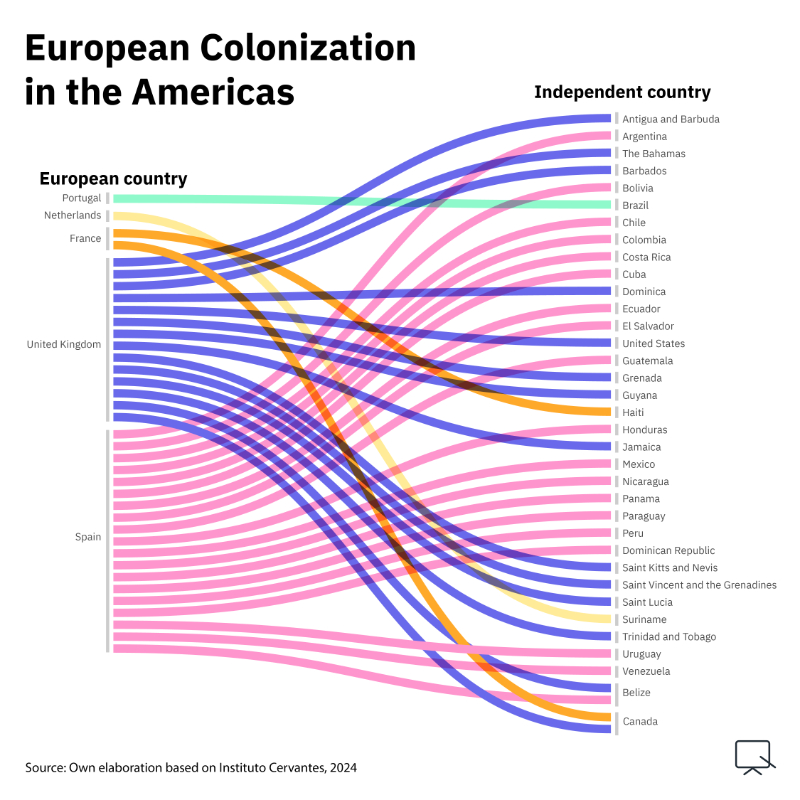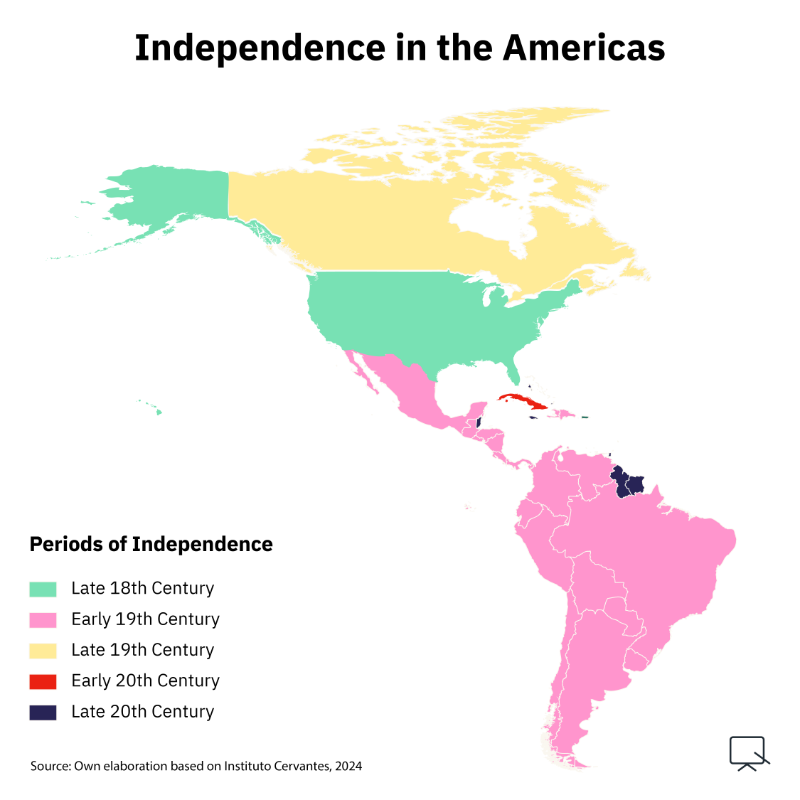Independence in the Americas: A Historical Overview
When discussing the independences in the Americas, it is essential to go beyond merely knowing the dates in a chronological sequence of events and explore the political, economic, and social factors that propelled these movements from the late 18th century to the 20th century.
Available in:
The American continent experienced a series of independence processes that profoundly transformed its political and social context. These movements, which developed over more than two centuries, were influenced by a set of global factors, including Enlightenment ideas, the French Revolution, and economic liberalism. Understanding the existing colonies and the territories they belonged to is key to comprehending the historical processes that led to the formation of the modern nations on the continent.
European Influence in America
This alluvial chart highlights the European influence in America, showing the connection between the colonized territories and their respective metropolises. A colony is a territory under the control and administration of a foreign country, known as the metropolis. These relationships shaped the social, political, and economic dynamics that eventually led to the independence movements in the colonies.

Spain dominated a large part of Central and South America, with colonies such as Mexico, Peru, Argentina and Chile, among others. Portugal had significant control in Brazil, while France had possessions in the Caribbean and Canada. Meanwhile, The United Kingdom established colonies in North America and some areas of Central America. Spain had the largest percentage of colonized territories, with 48.6%, followed by the United Kingdom with 40.5%, France with 5.4%, and finally, Portugal and the Netherlands with 2.7% each.
Cultural Syncretism: The Establishment of New Languages and Manners
The impact of colonial influence on the languages and customs of Pre-Colonial America reveals the complexity of our historical heritage. Since the arrival of Europeans to the American continent, identity elements such as language, religion, and social organization models were introduced, these persist and coexist with the cosmology of the native societies.
Spanish, introduced by Spain, became the predominant language in a large part of Central and South America, bringing with it Catholicism and leaving its mark on architecture and local traditions.
On the other part, Portugal left Portuguese as a legacy in Brazil, contributing to a rich cultural mix with African and indigenous influences. France had a significant influence in the Caribbean and Quebec, where French persists as the official language and customs reflect a fusion of European and local elements. The United Kingdom, with its expansion into North America and the Caribbean, established English as the dominant language in these regions, influencing significantly their political and social systems.

America’s Independence Periods
In the following map, we present the periods of independence of some countries in America, differentiated by colors. This visualization aims to show how waves of independence movements did not occur in isolation but were interconnected.
In the British colonies, the American Revolution at the end of the 18th century was an early example of how tensions between the colonies and the metropolis could lead to independence, resulting in the liberation of the Thirteen British Colonies, which we now know as the United States.
In the case of Latin America and the Caribbean, the first independent nation was Haiti, at the beginning of the 19th century, in the year 1804, achieving its independence from France. The Haitian Revolution was significant not only for its success but also because it was led by freed slaves, sending a powerful message of freedom and equality.
For the other colonies located in Latin America, the breaking point came at the beginning of the 19th century, largely due to the tensions caused by the Napoleonic Wars in Europe, which weakened Spain and Portugal’s control over their colonies, creating an opportunity for independence movements in America. Figures like Simón Bolívar, in the territories of Gran Colombia, and José de San Martín, who promoted the emancipation of Argentina, Chile, and Peru, played crucial roles in these processes.
Towards the end of the 20th century, several Caribbean territories, such as the Bahamas, Belize, and Jamaica, achieved their independence from the United Kingdom. In this region, it is characteristic to maintain certain relationships with the metropolises, as some territories are still under the tutelage of the United Kingdom, the Netherlands, France, or the United States.
Beyond discussing the dates of independence, we emphasize the importance of having precise and clear information that includes the historical context of the Americas. This is crucial for better understanding the current geopolitical, economic, cultural, and social configuration of the continent.




